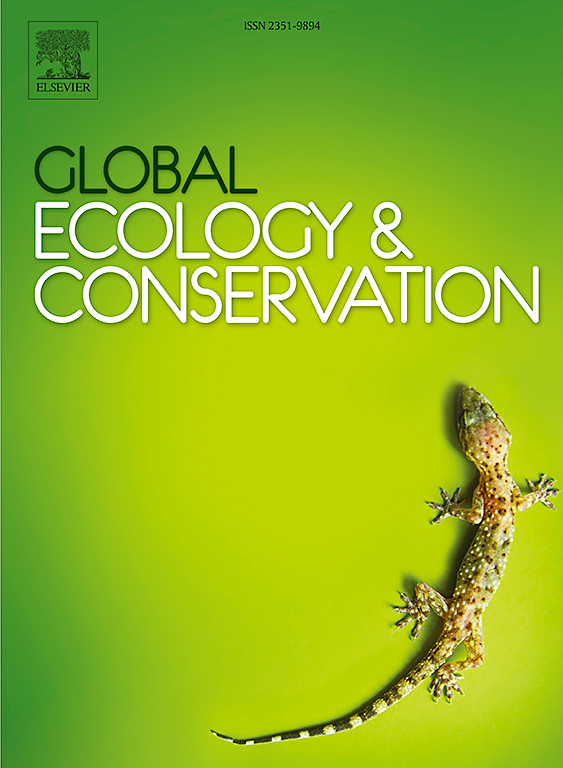贺兰山阿尔卑斯麝的饮食适应和营养转移
IF 3.4
2区 环境科学与生态学
Q1 BIODIVERSITY CONSERVATION
引用次数: 0
摘要
高山麝(Moschus chrysogaster)是贺兰山破碎生境中现存不足200只的濒危物种,面临着明显的资源季节性波动。本研究通过2014年至2016年的粪便显微组织学和饲料近似分析,研究了日粮组成、营养摄入和对次生植物代谢物耐受性的季节变化。夏季取食植物31种,以苔藓(18.15 %)、西伯利亚李(11.32 %)和柳(10.94 %)为主;冬季取食植物30种,以毛忍冬(13.68 %)和中国黄芩(11.33 %)为主,完全不取食苔藓。水(W)和粗灰分(CA)含量有显著的季节变化,夏季较高。采食量相对密度夏季与CA呈显著正相关,冬季与粗脂肪(EE)呈显著正相关。响应面模型揭示了特定的季节觅食模式:在冬季,马鹿偏好高能量和高蛋白食物,对单宁含量较高具有耐受性;而在夏季,马鹿偏好低蛋白质和高单宁食物,与能量含量无关。这些发现强调了贺兰山高山麝应对季节性资源波动的适应能力,有助于它们的生存和繁殖成功,从而为强调栖息地连通性和保护关键觅食区域以确保长期生存能力的保护策略提供信息。本文章由计算机程序翻译,如有差异,请以英文原文为准。
Dietary adaptations and nutritional shift of Alpine musk deer in Helan mountains, north China
The Alpine musk deer (Moschus chrysogaster), an endangered species with fewer than 200 individuals in fragmented habitats of the Helan mountains, faces pronounced seasonal resource fluctuations. This study investigates seasonal shifts in diet composition, nutrient intake, and tolerance to secondary plant metabolites via fecal microhistological and feed proximate analyses conducted from 2014 to 2016. In summer, the diet included 31 plant species, dominated by mosses (18.15 %), Prunus sibirica (11.32 %), and Salix spp. (10.94 %), whereas winter diets of 30 species shifted toward woody and herbaceous plants such as Lonicera edulis (13.68 %) and Astragalus chingianus (11.33 %), with complete exclusion of mosses. Significant seasonal variations were observed in the Water (W) and Crude ash (CA) content, with higher levels recorded in summer. The relative density of food intake was significantly positively correlated with CA in summer and with Ether extract (EE) in winter. Response surface models revealed specific seasonal foraging patterns: in winter, musk deer prefer high-energy and high-protein foods, with tolerance to higher tannin level, while in summer, they favor low-protein and high-tannin foods, irrespective of energy content. These findings highlight the adaptive capacity of Alpine musk deer to cope with seasonal resource fluctuations in Helan mountains, contributing to their survival and reproductive success, and thus inform conservation strategies that emphasize habitat connectivity and protection of critical foraging areas to ensure long-term viability.
求助全文
通过发布文献求助,成功后即可免费获取论文全文。
去求助
来源期刊

Global Ecology and Conservation
Agricultural and Biological Sciences-Ecology, Evolution, Behavior and Systematics
CiteScore
8.10
自引率
5.00%
发文量
346
审稿时长
83 days
期刊介绍:
Global Ecology and Conservation is a peer-reviewed, open-access journal covering all sub-disciplines of ecological and conservation science: from theory to practice, from molecules to ecosystems, from regional to global. The fields covered include: organismal, population, community, and ecosystem ecology; physiological, evolutionary, and behavioral ecology; and conservation science.
 求助内容:
求助内容: 应助结果提醒方式:
应助结果提醒方式:


